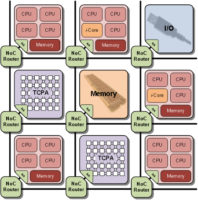10 million euros for invasive processor systems
CRC/Transregio 89 has been approved for a third phase of funding
The collaborative research centre/Transregio 89 ‘Invasive computing’ has entered into the third phase of approval and has been granted funding for a further four years. The German Research Foundation (DFG) has provided 10 million euros for research into parallel computing systems of the future. CRC/Transregio 89 is coordinated by the Chair of Computer Science 12 (Hardware/Software Co-Design) at FAU. The Chair of Computer Science 4 (Distributed Systems and Operating Systems) and Chair of Computer Science 1 (IT Security Infrastructure) are also involved, as are Karlsruhe Institute of Technology (KIT) and Technische Universität München (TUM).
Researchers at FAU, KIT and TUM have been researching new methods of distributing resources in computers since 2010. This is necessary, as new areas of application such as in avionics, the automotive industry and the digital revolution within industry bring even the most powerful multi-processor systems to their limits. True, in a few years it will be possible to integrate more than 1,000 processors on one chip. However, the more components are integrated into one system, the more difficult it is to distribute programmes effectively or fairly over so many processors. The approach taken by the researchers is that available resources should be allocated intelligently, not arbitrarily. In future, programmes will operate ‘invasively’, only requesting computing capacity when it is actually required or can be used efficiently. In return, they are exclusively allocated free processor regions, before releasing them again to be used subsequently by other applications. ‘Distributing resources dynamically and autonomously requires a complete re-think of our programming philosophy and system architecture,’ says Prof. Dr. Jürgen Teich, Chair of Hardware/Software Co-Design and spokesman for CRC/Transregio 89.
Predictability thanks to invasion
In the first two phases of funding, the computer scientists were able to prove the efficiency of invasive computing – for example in complex applications for vehicle assistance systems or when robots are required to process images in real time. They are helped by one inherent property of invasive computing: programmes work in isolation. This entails considerable improvements in predicting non-functional properties, such as execution time. ‘Our project is unique in its ability to specify programme requirements such as these, and be able to meet them even in multi-processor systems,’ says Jürgen Teich. ‘At the end of the day, the decisive factor for a number of applications which are relevant from a security point of view is not maximum computing performance, but rather a guarantee that they will perform as required when required.’ The new concept does not only mean that resources are used more efficiently, it also leads to massive energy savings and adds an additional security aspect, as the individual programmes are kept separate from one another.
Closing the gaps
The researchers from FAU, KIT and TUM intend using the new DFG funding to close the final gaps in preparing invasive computing systems for use in industry. The main focus is on reducing remaining insecurities caused by variable programming properties, environmental conditions and machine status. Jürgen Teich: ‘We are investigating procedures for analysing robustness and automatically generating modules which monitor the individually allocated time, energy and security properties for the running time and ensure that they are complied with. We are creating a link between resource-aware programming and keeping non-functional properties of parallel programmes on multi-processor systems. The expected results could considerably boost the use of multi-processor systems in integrated and cyber-physical systems in daily life, becoming extremely important for industry.
Further information on the research conducted by CRC/Transregio 89 can be found on its website.
Further information:
Prof. Dr.-Ing. Jürgen Teich
Phone: +49 9131 8525150
juergen.teich@fau.de
